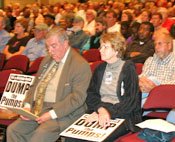Opponents and supporters of the $220 million Yazoo Backwater Area Project spoke out at a public hearing in Vicksburg last Thursday. The project, which involves installing a huge pumping station to drain 66,945 acres of Delta wetlands, horrifies many environmentalists, who say the 60-year-old endeavor is a leftover from a more callous age.
The U.S. Army Corps of Engineers is pushing the project, backed by U.S. Sen. Thad Cochran and Gov. Haley Barbour, who argue that the plan would prevent some flooding and open more Delta land for farming. But the Environmental Protection Agency said in March that it intended to veto the project under the language of the U.S. Clean Water Act, citing irrevocable damage to the area's wildlife population and the possible degradation of the water supply.
The EPA is not the environmental champion it was in the 1970s—arguably the height of the nation's environmental and regulatory movement. It has not unilaterally vetoed a project in more than 10 years—testament, perhaps, to the amount of concern the agency has for the biggest pump project proposed in decades.
Both opponents and supporters of the veto spent hours ranting before EPA officials inside the Vicksburg Convention Center.
"I have concern that a single federal agency has the authority to personally stop a congressionally authorized project," said staffer Brad Davis, speaking on behalf of Cochran.
Barbour representative Neely Carlton said the governor had been surprised by the EPA's decision, saying Barbour expected the project to have "satisfied or exceeded EPA's recommended changes to earlier proposals to this project."
A letter from Barbour expressed "the governor's deepest empathy for the property owners whose homes are flooded at this time," Carlton said, explaining that Barbour's own Humphreys County lake house is currently flooded.
"While (Barbour's) property may not have directly benefited (from the Yazoo pumps project), his experience makes him deeply sympathetic to the situation," Carlton read.
In his letter, Barbour attempted to classify opponents to the plan as outsiders.
"The overwhelming majority of the negative comments received against the project are by individuals who do not live in the affected area, or even in Mississippi." Barbour wrote, without acknowledging in his letter that the project's $220 million price tag would mostly be carried by taxpayers also living outside the state. "[S]outh Delta region residents accepted the responsibility, but their acceptance was based on a promise that the water that backed up onto their property would be pumped into the Mississippi River."
The project is among the more controversial proposed by the Mississippi Army Corps of Engineers. John Meagher, retired director of the EPA's Wetland's Division, wrote a letter to The New York Times saying the pump station would "do more damage to the environment" than any other proposal Meagher had reviewed "over the course of my 24 years at the EPA," and added that the initial cost of construction did not include the "millions more every year thereafter for operation and maintenance, energy costs and crop support payments."
Opponents to the project outnumbered defenders at the hearing by a handful. The event, which began at 7 p.m., entertained about 80 speakers and stretched well past 12:15 in the morning.
Anguilla resident Emma Cooper-Harris said the $220 million could be better spent directly on the people of Sharkey County.
"This pump project is another welfare project for large landowners. In Sharkey County, we have the highest unemployment rate in this state, the highest teen pregnancy in the state, lowest income and the most unskilled citizens in this state, with $220 million going to the pumps," Cooper-Harris said. "... If you got $220 million to give away, give it to Sharkey County."
Mississippi Sierra Club Director Louie Miller said the pumping station, while impacting wetlands spanning the length of four Manhattan-sized islands, would only benefit a few hundred people. Issaquena and Sharkey counties, for example, only have about 7,000 residents between them, and most of those residents do not live in areas prone to flooding.
"Inside the levees, in the Yazoo backwater area that the pumps are supposed to be located in, there's no flooding. Not even right now, with the damn river as high as it is, there's no flooding on occupied lands. That is a complete fabrication," Miller said.
"Before 1978, before the completion of the backwater levee, yes, there was flooding, but the pumps are obsolete now because the Army Corps of Engineers completed the levees."
EPA officials said they would take into account both written and spoken presentations before moving forward with their veto.



Comments
Use the comment form below to begin a discussion about this content.
comments powered by Disqus